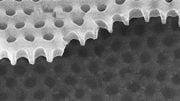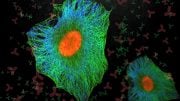
Illustration of the crystal structure of the yttrium alloy, with the red line at left representing the laser pulse in and the blue and green lines at right representing the two types of magnons created. Credit: Illustration courtesy of University of Texas at Austin & MIT researchers
A recent study has advanced the understanding of magnonics by showing how magnons can interact nonlinearly, marking a critical step towards faster and more stable computing technologies.
- If computers used ripples in magnetic fields, called magnons, to encode and process information, the result would be devices with potential memory speed on the order of billionths of a second.
- UCLA researchers and partners caused two distinct types of magnons to interact so that output is not directly proportional to input — a crucial step toward computing advances.
- This multi-institution, long-term research collaboration is studying magnons using a rarely used but promising terahertz laser technology.
Exploring the Future of Computing With Magnons
One vision for the future of computing involves using ripples in magnetic fields — called magnons — as a basic mechanism. In this application, magnons would be comparable to electricity as the basis for electronics.
In conventional digital technologies, such magnonic systems are expected to be far faster than today’s technologies, from laptops and smartphones to telecommunications. In quantum computing, the advantages of magnonics could include not only quicker speeds but also more stable devices.
A recent study[1] in the journal Nature Physics reports an early-stage discovery along the path to developing magnonic computers. The researchers caused two distinct types of ripples in the magnetic field of a thin plate of alloy, measured the results and showed that the magnons interacted in a nonlinear manner. “Nonlinear” refers to output that is not directly proportional to input — a necessity for any sort of computing application.
To date, most research in this area has focused on one type of magnon at a time, under relatively stable conditions described as equilibrium. Manipulating the magnons, as done in these studies, pushes the system out of equilibrium.
Advancing Nonequilibrium Physics
This is one of many investigations underway through a multiyear collaboration between theorists and experimentalists from multiple fields of science and engineering, including a second study[2] that recently appeared in Nature Physics. The project, supported by government and private grantors, brings together researchers from UCLA, MIT, the University of Texas at Austin and the University of Tokyo in Japan.
“With our colleagues, we’ve started what I would call a campaign to spur progress in nonequilibrium physics,” said Prineha Narang, a co-author of the study and professor of physical sciences in UCLA College. “What we’ve done here fundamentally advances the understanding of nonequilibrium and nonlinear phenomena. And it could be a step toward computer memory using ultrafast phenomena that happen on the order of billionths of a second.”
One key technology behind these findings is an advanced technique for adding energy to and evaluating samples using lasers with frequencies in the terahertz range, which sits between the wavelengths of microwave and infrared radiation. Adopted from chemistry and medical imaging, the method is applied only rarely to study magnetic fields.
According to Narang, who is a member of the California NanoSystems Institute at UCLA, the use of terahertz lasers suggests potential synergy with a technology growing in maturity.
“Terahertz technology itself has reached the point where we can talk about a second technology that relies on it,” she said. “It makes sense to do this type of nonlinear control in a band where we have lasers and detectors that can be put on a chip. Now is the time to really push forward because we have both the technology and an interesting theoretical framework for looking at interactions among magnons.”
Unveiling Nonlinear Interactions in Magnonics
The researchers applied laser pulses to a 2-millimeter-thick plate made from a carefully chosen alloy containing yttrium, a metal found in LEDs and radar technology. In some experiments, a second terahertz laser was used in a coordinated way that paradoxically added energy but helped stabilize samples.
A magnetic field was applied to the yttrium in a specific fashion that allowed for only two types of magnon. The investigators were able to drive either type of magnon individually or both at the same time by rotating the sample to certain angles relative to the lasers. They were able to measure the interactions between the two types and found that they could cause nonlinear responses.
“Clearly demonstrating this nonlinear interaction would be important for any sort of application based on signal processing,” said co-author Jonathan Curtis, a UCLA postdoctoral researcher in the NarangLab. “Mixing signals like this could allow us to convert between different magnetic inputs and outputs, which is what you need for a device that relies on manipulating information magnetically.”
Narang said that trainees are vital to the current study, as well as the larger project.
“This is a really hard, multiyear endeavor with a lot of pieces,” she said. “What’s the right system and how do we go about working with it? How do we think about making predictions? How do we limit the system so it’s behaving as we want it to? We wouldn’t be able to do this without talented students and postdocs.”
For more on this research, see How Invisible Light Is Shaping the Future of High-Speed Computing.
References:
- “Terahertz field-induced nonlinear coupling of two magnon modes in an antiferromagnet” by Zhuquan Zhang, Frank Y. Gao, Jonathan B. Curtis, Zi-Jie Liu, Yu-Che Chien, Alexander von Hoegen, Man Tou Wong, Takayuki Kurihara, Tohru Suemoto, Prineha Narang, Edoardo Baldini and Keith A. Nelson, 31 January 2024, Nature Physics.
DOI: 10.1038/s41567-024-02386-3 - “Terahertz-field-driven magnon upconversion in an antiferromagnet” by Zhuquan Zhang, Frank Y. Gao, Yu-Che Chien, Zi-Jie Liu, Jonathan B. Curtis, Eric R. Sung, Xiaoxuan Ma, Wei Ren, Shixun Cao, Prineha Narang, Alexander von Hoegen, Edoardo Baldini and Keith A. Nelson, 23 January 2024, Nature Physics.
DOI: 10.1038/s41567-023-02350-7
The study includes MIT chemistry professor Keith Nelson and UT Austin physics professor Edoardo Baldini, along with the UCLA team led by Narang, which was supported by the Quantum Science Center, a Department of Energy National Quantum Information Science Research Center headquartered at Oak Ridge National Laboratory. The study was primarily supported by the Department of Energy as well as the Alexander von Humboldt Foundation, the Gordon and Betty Moore Foundation, the John Simon Guggenheim Memorial Foundation and the Japan Society for the Promotion of Science — all of which provide ongoing support for the collaboration.









The Nature research journals (such as Nature Physics, Scientific Reports, etc) are influenced by the journal Nature, and they are neither scientific nor honest. They stubbornly believe, like the Physical Review Letters (PRL), that two high-dimensional spacetime objects can form a mirror image of each other through reverse rotation.
The branch of mathematics known as topology has become a cornerstone of modern physics. The perpetually swirling topological vortices defy traditional physics’ expectations. A physical properties of topological vortices is their to spontaneously begin to change periodically in time, even though the system does not experience corresponding periodic interference. Therefore, in the interaction of topological vortices, time is both absolute and relative,and physics often requires treating space and time at the same level.
Low-dimensional spacetime matter is the foundation of high-dimensional spacetime matter. Low-dimensional spacetime matter (such as topological vortex) can form new material structures and derive more complex physical properties via interactions and self-organization. It is extremely wrong and irresponsible to imagine low dimensional spacetime matter using high-dimensional spacetime matter.
Science must follow mathematical rules. For example, the Standard Model (SM) is considered to be one of the most significant achievements of physics in the 20th century. However, the magnetic moment of μ particle is larger than expected, revealed by a g-2 experiment at Fermilab, suggests that the established theory (such as SM) of fundamental particles is incomplete. Furthermore, the SM omitting gravity, it not involved the time problem and when the particle movement starts. Mathematics is the foundation of science. Physics must respect the scientific nature of mathematics and mathematical models. The SM must be based on mathematical models in order to be scientific, convincing, and in line with natural laws.
I hope researchers are not fooled by the pseudoscientific theories of the Physical Review Letters (PRL), and hope more people dare to stand up and fight against rampant pseudoscience.
The so-called academic journals (such as Physical Review Letters, Nature, Science, etc.) firmly believe that two high-dimensional spacetime objects (such as two sets of cobalt-60) rotating in opposite directions can be transformed into two objects that mirror each other, is a typical case of pseudoscience rampant.
If researchers are really interested in Science and Physics, you can browse https://zhuanlan.zhihu.com/p/643404671 and https://zhuanlan.zhihu.com/p/595280873.